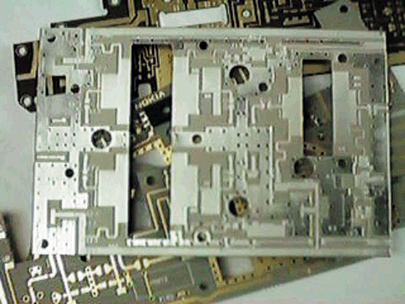ORGANIC CERAMIC MICROWAVE SUBSTRATE MATERIALS

The ORCER family of copper clad substrate material is formulated to combine the property advantages of fluoropolymer organic chemistry with ceramic elements. The development of this technology has enabled the creation of a wide range of high value products that provide superior electrical and reliability performance while maintaining ease and efficient processing of high frequency printed circuit boards through assembly.
The new material's properties include low electrical loss, good rigidity and dimensional stability, high copper peel strength, low thermal expansion rates, stable dielectric constant and low moisture absorption across a range of dielectric constants from 3.0 to 10. Among the new products manufactured using ORCER technology and currently available for delivery are RF-60 and RF-30 laminates.
RF-60 LAMINATE

Fig. 1 RF-60 dielectric constant vs. frequency.

Fig. 2 RF-60 dissipation factor vs. frequency.
The RF-60 material is based on woven glass reinforcement and features a dielectric constant of 6.15 and dissipation factor of 0.0028 at 10 GHz. Figures 1 and 2 show the material's dielectric constant er and dissipation factor tan d vs. frequency, respectively. The high dielectric constant allows for circuit miniaturization. The ceramic elements provide mechanical strength and thermal stability for consistent dielectric constant and plated through hole reliability over temperature cycling. The material exhibits exceptional interlaminar bond strength and solder resistance. The mechanical strength provides rigidity and a hard surface for mounting connectors and other components. The rigidity and XY dimensional stability allow circuit board fabricators and assemblers to process the boards with greater efficiency. RF-60 material can be sheared, drilled, milled and plated using standard methods for polytetrafluoroethylene (PTFE)-woven fiberglass materials. The Z-axis coefficient of thermal expansion (CTE) is 46 ppm/°C, allowing for superior plated-through-hole reliability in extreme thermal environments. Table 1 lists the RF-60 material's typical properties.
The RF-60 laminates are generally supplied clad on both sides with 1/2, 1 or 2 oz. electrodeposited copper. The material is available in a standard master sheet size of 36" ¥ 48". However, various panel sizes can be supplied.
|
RF-60 TYPICAL PROPERTIES | |
|
Dielectric constant |
6.15 ±0.25 |
|
Dissipation factor at 1.9 GHz |
0.0021 |
|
Flexural strength (lbs/in) |
25,000 |
|
Tensile strength (psi) |
28,900 |
|
Peel strength (1 oz. ed) (lbs/linear in) |
> 10 |
|
Dimensional stability (mils/in) |
-0.06 |
|
Thermal conductivity (W/m-K) |
0.539 |
|
CTE (Z axis) (ppm/¡C) (0-100¡C) |
75 |
|
Flammability rating meets |
V - 0 |
The high reliability of RF-60 coupled with its low cost and processing efficiency makes it one of the best-valued dielectric constant 6 materials in the microwave industry. RF-60 is a general-purpose material used for power amplifiers, components, and antennas.
RF-30 MATERIAL
The RF-30 material is specifically developed to meet the demands for low intermodulation performance of base station antennas. The material features a dielectric constant of 3.0 and exhibits a dissipation factor of 0.002 @ 10 GHz. In addition, the material offers IM3 performance of -108 dBm at 1.9 GHz (0.060" thickness). RF-30 is mechanically rigid, has high copper peel strength and is available in standard lengths up to 110".
RF-30 is the microwave industry's lowest priced material available with this performance. Both RF-30 and RF-60 laminates are tested in accordance with the IPC-TM650 test specification. A certificate of compliance containing lot-specific test data accompanies each shipment.
Taconic Advanced Dielectric Division, Petersburgh, NY (518) 658-3202.
